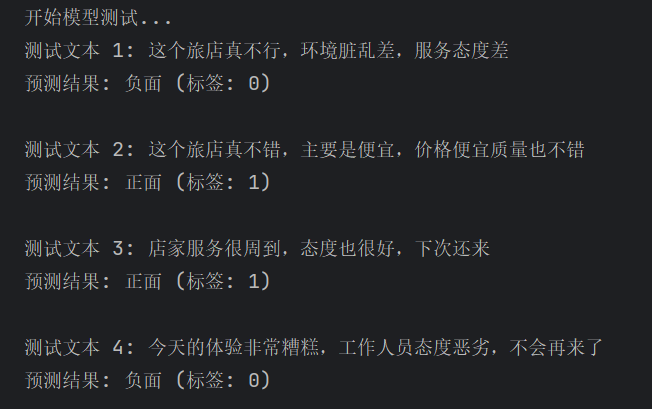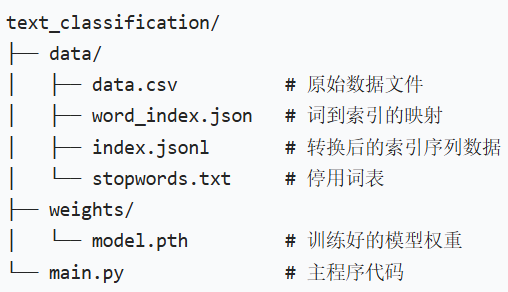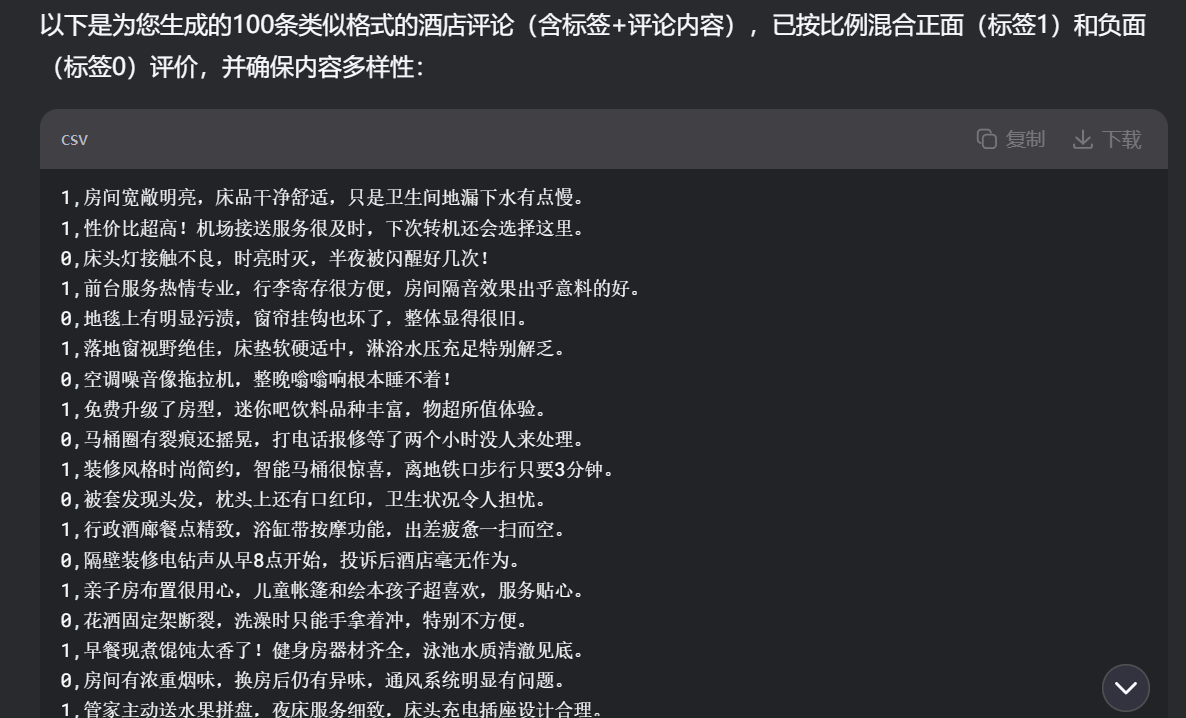[语言模型训练]基于 PyTorch 的双向 LSTM 文本分类器实现:基于旅店的评论分类语言模型
在自然语言处理领域,文本分类是一项基础且重要的任务,广泛应用于情感分析、垃圾邮件识别、新闻分类等场景。本文将详细介绍如何使用 PyTorch 实现一个基于双向 LSTM 的文本分类模型,从数据预处理到模型训练、评估和预测,一步一步带你完成整个流程。
【本博客的模型主要是对旅店的评论进行好评和差评的二分类】
【效果展示】

【后附有源码,复制粘贴即可运行,自动创建目录并给出数据集提示,非常方便!】
【本猿定期无偿分享学习成果,欢迎关注一起学习!!!】
一.环境准备
1.必要包安装
首先,确保你已经安装了以下必要的 Python 库:
pip install torch numpy pandas jieba scikit-learn-
torch:PyTorch 深度学习框架
-
numpy:数值计算库
-
jieba:中文分词工具
-
scikit-learn:提供数据分割等工具
2.项目结构设计
在开始编写代码前,我们先规划一下项目的目录结构:

二.定义路径和基础配置
接下来,我们定义数据文件路径、模型保存路径以及一些基础配置参数:
# 数据文件路径定义与基础配置csv_path = os.path.relpath(os.path.join(os.path.dirname(__file__), \'./data\', \'data.csv\'))word_index_path = os.path.relpath(os.path.join(os.path.dirname(__file__), \'./data\', \'word_index.json\'))index_path = os.path.relpath(os.path.join(os.path.dirname(__file__), \'./data\', \'index.jsonl\'))model_path = os.path.relpath(os.path.join(os.path.dirname(__file__), \'./weights\', \'model.pth\'))stopwords_path = os.path.relpath(os.path.join(os.path.dirname(__file__), \'./data\', \'stopwords.txt\')) # 停用词文件路径# 文本处理配置punk = \',。!?,.:;!?()[]{}\"\\\' \' # 标点符号集合line_length_threshold = 100 # 文本序列最大长度# 设备配置,自动选择GPU或CPUdevice = torch.device(\"cuda\" if torch.cuda.is_available() else \"cpu\")
三.目录和文件检查工具
为了确保程序能够正常运行,我们需要创建必要的目录并检查数据文件是否存在:
# 检查并创建必要的目录def create_necessary_directories(): \"\"\"创建程序运行所需的所有目录\"\"\" directories = [ os.path.dirname(csv_path), os.path.dirname(model_path), os.path.dirname(stopwords_path) ] for dir_path in directories: if not os.path.exists(dir_path): os.makedirs(dir_path, exist_ok=True) print(f\"已创建目录: {dir_path}\")# 检查CSV文件是否存在def check_csv_file(): \"\"\"检查CSV文件是否存在,如果不存在则提示用户添加\"\"\" if not os.path.exists(csv_path): print(f\"\\n错误: 未在 {csv_path} 找到数据文件\") print(f\"请将 data.csv 文件添加到 {os.path.dirname(csv_path)} 目录下\") print(\"CSV文件格式应为: 第一列为标签(0或1),第二列为文本内容\") return False return True四.停用词处理
中文文本处理中,停用词过滤是一个重要步骤,可以去除对分类贡献不大的常用词:
# 加载停用词def load_stopwords(): \"\"\"加载停用词表,若不存在则创建默认停用词表\"\"\" if not os.path.exists(stopwords_path): # 默认停用词(可根据需求扩展) default_stopwords = [\"的\", \"了\", \"在\", \"是\", \"我\", \"有\", \"和\", \"就\", \"人\", \"都\", \"一\", \"一个\", \"上\", \"也\", \"很\", \"到\", \"说\", \"要\", \"去\", \"你\", \"会\", \"着\", \"没有\", \"看\", \"好\", \"自己\", \"这\"] with open(stopwords_path, \'w\', encoding=\'utf-8\') as f: f.write(\'\\n\'.join(default_stopwords)) print(f\"已创建默认停用词表: {stopwords_path}\") with open(stopwords_path, \'r\', encoding=\'utf-8\') as f: return set(f.read().splitlines())五.数据预处理
文本数据需要转换为模型可以处理的数值形式,这一步包括构建词索引和将文本转换为索引序列:
# 构建词到索引的映射表(含停用词过滤)def build_word_index(): index = 1 word_index = {} stopwords = load_stopwords() with open(csv_path, \'r\', encoding=\'utf-8-sig\') as f, \\ open(word_index_path, \'w\', encoding=\'utf-8-sig\') as f1: reader = csv.reader(f) for row in reader: if len(row) < 2: continue text = row[1] words = jieba.cut(text) # 使用jieba进行中文分词 for word in words: # 过滤停用词、标点和空字符 if word.strip() and word not in punk and word not in stopwords and word not in word_index: word_index[word] = index index += 1 json.dump(word_index, f1, ensure_ascii=False) print(f\"已构建词索引表: {word_index_path}\") return word_index# 加载词索引表def load_word_index(): if not os.path.exists(word_index_path): return build_word_index() with open(word_index_path, \'r\', encoding=\'utf-8-sig\') as f: return json.load(f)# 将文本转换为索引序列(含停用词过滤)def convert_text_to_index(): word_index = load_word_index() stopwords = load_stopwords() with open(csv_path, \'r\', encoding=\'utf-8-sig\') as f, \\ open(index_path, \'w\', encoding=\'utf-8-sig\') as f1: reader = csv.reader(f) for row in reader: if len(row) < 2: continue label, text = row[0], row[1] line_indexes = [] words = jieba.cut(text) for word in words: # 过滤停用词、标点和空字符,并检查词是否在词表中 if word.strip() and word not in punk and word not in stopwords and word in word_index: line_indexes.append(word_index[word]) # 将索引序列和标签写入文件 f1.write(json.dumps({\"indexes\": line_indexes, \"label\": label}, ensure_ascii=False) + \'\\n\') print(f\"已将文本转换为索引序列: {index_path}\")六.加载预处理数据
将处理好的索引序列数据加载到内存,并进行长度统一处理:
def load_processed_data(): if not os.path.exists(index_path): convert_text_to_index() labels = [] inputs = [] with open(index_path, \'r\', encoding=\'utf-8-sig\') as f: for line in f: data = json.loads(line) indexes = data[\"indexes\"] label = int(data[\"label\"]) # 统一序列长度:超过阈值则截断,不足则补0 if len(indexes) > line_length_threshold: processed = indexes[:line_length_threshold] else: processed = indexes + [0] * (line_length_threshold - len(indexes)) inputs.append(processed) labels.append(label) print(f\"已加载预处理数据,共 {len(labels)} 条记录\") return inputs, labels七.构建数据加载器
使用 PyTorch 的 DataLoader 来方便地处理批量数据和数据打乱:
def get_data_loaders(test_size=0.2, random_state=42, batch_size=32): inputs, labels = load_processed_data() # 分割训练集和测试集,使用分层抽样保持类别比例 train_data, test_data, train_labels, test_labels = train_test_split( inputs, labels, test_size=test_size, random_state=random_state, stratify=labels ) # 转换为TensorDataset train_dataset = TensorDataset( torch.tensor(train_data, dtype=torch.long), torch.tensor(train_labels, dtype=torch.long) ) test_dataset = TensorDataset( torch.tensor(test_data, dtype=torch.long), torch.tensor(test_labels, dtype=torch.long) ) # 创建数据加载器 train_loader = DataLoader(train_dataset, batch_size=batch_size, shuffle=True) test_loader = DataLoader(test_dataset, batch_size=batch_size, shuffle=False) print(f\"数据加载完成 - 训练集: {len(train_dataset)} 条, 测试集: {len(test_dataset)} 条\") return train_loader, test_loader八.定义双向 LSTM 模型
我们使用双向 LSTM 结合池化操作来捕获文本的上下文信息:
class LSTMClassifier(nn.Module): \"\"\"基于双向LSTM+池化的文本分类模型\"\"\" def __init__(self, vocab_size, embedding_dim=256, hidden_dim=256, output_dim=2, num_layers=2, dropout=0.5): super(LSTMClassifier, self).__init__() # 嵌入层:将词索引转换为密集向量 self.embedding = nn.Embedding(vocab_size, embedding_dim, padding_idx=0) # 双向LSTM层 self.lstm = nn.LSTM( input_size=embedding_dim, hidden_size=hidden_dim, num_layers=num_layers, batch_first=True, # 第一个维度为batch_size bidirectional=True, # 双向LSTM dropout=dropout if num_layers > 1 else 0 # 多层时才使用dropout ) # 全连接层:双向LSTM输出维度为hidden_dim*2,拼接平均池化和最大池化结果 self.fc = nn.Linear(hidden_dim * 2 * 2, output_dim) # 2(双向)*2(两种池化) self.dropout = nn.Dropout(dropout) # Dropout层防止过拟合 def forward(self, x): # x shape: (batch_size, seq_len) embedded = self.dropout(self.embedding(x)) # (batch_size, seq_len, embedding_dim) lstm_out, _ = self.lstm(embedded) # (batch_size, seq_len, hidden_dim*2) # 池化操作(替代仅取最后一个时间步) avg_pool = torch.mean(lstm_out, dim=1) # (batch_size, hidden_dim*2) max_pool, _ = torch.max(lstm_out, dim=1) # (batch_size, hidden_dim*2) # 拼接两种池化结果 combined = torch.cat([avg_pool, max_pool], dim=1) # (batch_size, hidden_dim*2*2) return self.fc(self.dropout(combined))九.模型训练与评估
实现模型的训练过程,并加入学习率调度和早停机制防止过拟合:
def train_model(epochs=50, lr=0.001, batch_size=32): train_loader, test_loader = get_data_loaders(batch_size=batch_size) vocab_size = get_vocab_size() + 1 # +1 是因为索引从1开始 # 初始化模型、优化器和损失函数 model = LSTMClassifier(vocab_size).to(device) optimizer = opt.Adam(model.parameters(), lr=lr) criterion = nn.CrossEntropyLoss() # 学习率调度器:测试损失3轮不下降则乘以0.5 scheduler = opt.lr_scheduler.ReduceLROnPlateau( optimizer, mode=\'min\', patience=3, factor=0.5, verbose=True ) best_test_acc = 0.0 no_improve_epochs = 0 # 连续未提升轮数计数器 early_stop_patience = 10 # 提前停止阈值 print(f\"开始模型训练,使用设备: {device}\") for epoch in range(epochs): # 训练阶段 model.train() train_loss, train_correct = 0.0, 0 for texts, labels in train_loader: texts, labels = texts.to(device), labels.to(device) optimizer.zero_grad() # 清零梯度 outputs = model(texts) # 前向传播 loss = criterion(outputs, labels) # 计算损失 loss.backward() # 反向传播 optimizer.step() # 更新参数 train_loss += loss.item() train_correct += (outputs.argmax(1) == labels).sum().item() # 测试阶段 model.eval() test_loss, test_correct = 0.0, 0 with torch.no_grad(): # 关闭梯度计算 for texts, labels in test_loader: texts, labels = texts.to(device), labels.to(device) outputs = model(texts) loss = criterion(outputs, labels) test_loss += loss.item() test_correct += (outputs.argmax(1) == labels).sum().item() # 计算指标 train_acc = train_correct / len(train_loader.dataset) test_acc = test_correct / len(test_loader.dataset) avg_train_loss = train_loss / len(train_loader) avg_test_loss = test_loss / len(test_loader) # 打印信息 print(f\"\\nEpoch {epoch + 1}/{epochs}\") print(f\"Train Loss: {avg_train_loss:.4f} | Acc: {train_acc:.4f}\") print(f\"Test Loss: {avg_test_loss:.4f} | Acc: {test_acc:.4f}\") # 学习率调度 scheduler.step(avg_test_loss) # 保存最佳模型与提前停止判断 if test_acc > best_test_acc: best_test_acc = test_acc torch.save(model.state_dict(), model_path) print(f\"保存最佳模型 (Test Acc: {best_test_acc:.4f}) 到 {model_path}\") no_improve_epochs = 0 # 重置计数器 else: no_improve_epochs += 1 print(f\"连续 {no_improve_epochs} 轮测试准确率未提升\") if no_improve_epochs >= early_stop_patience: print(f\"触发提前停止({early_stop_patience}轮未提升)\") break return best_test_accdef evaluate_model(): _, test_loader = get_data_loaders() vocab_size = get_vocab_size() + 1 model = LSTMClassifier(vocab_size).to(device) model.load_state_dict(torch.load(model_path)) # 加载最佳模型权重 model.eval() criterion = nn.CrossEntropyLoss() test_loss, test_correct = 0.0, 0 with torch.no_grad(): for texts, labels in test_loader: texts, labels = texts.to(device), labels.to(device) outputs = model(texts) loss = criterion(outputs, labels) test_loss += loss.item() test_correct += (outputs.argmax(1) == labels).sum().item() test_acc = test_correct / len(test_loader.dataset) print(f\"\\n最终评估结果:\") print(f\"Test Loss: {test_loss / len(test_loader):.4f} | Test Acc: {test_acc:.4f}\") return test_accdef get_vocab_size(): return len(load_word_index())十.预测函数
实现对新文本的预测功能:
def predict_text(text): word_index = load_word_index() stopwords = load_stopwords() vocab_size = get_vocab_size() + 1 # 文本预处理:分词、过滤停用词、转换为索引 words = jieba.cut(text) indexes = [] for word in words: if word.strip() and word not in punk and word not in stopwords and word in word_index: indexes.append(word_index[word]) # 统一序列长度 if len(indexes) > line_length_threshold: indexes = indexes[:line_length_threshold] else: indexes += [0] * (line_length_threshold - len(indexes)) # 转换为张量并添加批次维度 input_tensor = torch.tensor(indexes, dtype=torch.long).unsqueeze(0).to(device) # 加载模型并预测 model = LSTMClassifier(vocab_size).to(device) model.load_state_dict(torch.load(model_path)) model.eval() with torch.no_grad(): output = model(input_tensor) prediction = torch.argmax(output, dim=1).item() return prediction十一.完整源代码
import osimport jsonimport torchimport numpy as npimport csvimport jiebafrom torch.utils.data import DataLoader, TensorDatasetfrom sklearn.model_selection import train_test_splitimport torch.nn as nnimport torch.optim as opt# 数据文件路径定义与基础配置csv_path = os.path.relpath(os.path.join(os.path.dirname(__file__), \'./data\', \'data.csv\'))word_index_path = os.path.relpath(os.path.join(os.path.dirname(__file__), \'./data\', \'word_index.json\'))index_path = os.path.relpath(os.path.join(os.path.dirname(__file__), \'./data\', \'index.jsonl\'))model_path = os.path.relpath(os.path.join(os.path.dirname(__file__), \'./weights\', \'model.pth\'))stopwords_path = os.path.relpath(os.path.join(os.path.dirname(__file__), \'./data\', \'stopwords.txt\')) # 停用词文件路径punk = \',。!?,.:;!?()[]{}\"\\\' \'line_length_threshold = 100device = torch.device(\"cuda\" if torch.cuda.is_available() else \"cpu\")# 新增:检查并创建必要的目录def create_necessary_directories(): \"\"\"创建程序运行所需的所有目录\"\"\" directories = [ os.path.dirname(csv_path), os.path.dirname(model_path), os.path.dirname(stopwords_path) ] for dir_path in directories: if not os.path.exists(dir_path): os.makedirs(dir_path, exist_ok=True) print(f\"已创建目录: {dir_path}\")# 新增:检查CSV文件是否存在def check_csv_file(): \"\"\"检查CSV文件是否存在,如果不存在则提示用户添加\"\"\" if not os.path.exists(csv_path): print(f\"\\n错误: 未在 {csv_path} 找到数据文件\") print(f\"请将 data.csv 文件添加到 {os.path.dirname(csv_path)} 目录下\") print(\"CSV文件格式应为: 第一列为标签(0或1),第二列为文本内容\") return False return True# 新增:加载停用词def load_stopwords(): \"\"\"加载停用词表,若不存在则创建默认停用词表\"\"\" if not os.path.exists(stopwords_path): # 默认停用词(可根据需求扩展) default_stopwords = [\"的\", \"了\", \"在\", \"是\", \"我\", \"有\", \"和\", \"就\", \"不\", \"人\", \"都\", \"一\", \"一个\", \"上\", \"也\", \"很\", \"到\", \"说\", \"要\", \"去\", \"你\", \"会\", \"着\", \"没有\", \"看\", \"好\", \"自己\", \"这\"] with open(stopwords_path, \'w\', encoding=\'utf-8\') as f: f.write(\'\\n\'.join(default_stopwords)) print(f\"已创建默认停用词表: {stopwords_path}\") with open(stopwords_path, \'r\', encoding=\'utf-8\') as f: return set(f.read().splitlines())# 数据预处理函数def build_word_index(): \"\"\"构建词到索引的映射表(含停用词过滤)\"\"\" index = 1 word_index = {} stopwords = load_stopwords() with open(csv_path, \'r\', encoding=\'utf-8-sig\') as f, \\ open(word_index_path, \'w\', encoding=\'utf-8-sig\') as f1: reader = csv.reader(f) for row in reader: if len(row) < 2: continue text = row[1] words = jieba.cut(text) for word in words: # 新增:过滤停用词 if word.strip() and word not in punk and word not in stopwords and word not in word_index: word_index[word] = index index += 1 json.dump(word_index, f1, ensure_ascii=False) print(f\"已构建词索引表: {word_index_path}\") return word_indexdef load_word_index(): if not os.path.exists(word_index_path): return build_word_index() with open(word_index_path, \'r\', encoding=\'utf-8-sig\') as f: return json.load(f)def convert_text_to_index(): \"\"\"将文本转换为索引序列(含停用词过滤)\"\"\" word_index = load_word_index() stopwords = load_stopwords() with open(csv_path, \'r\', encoding=\'utf-8-sig\') as f, \\ open(index_path, \'w\', encoding=\'utf-8-sig\') as f1: reader = csv.reader(f) for row in reader: if len(row) line_length_threshold: processed = indexes[:line_length_threshold] else: processed = indexes + [0] * (line_length_threshold - len(indexes)) inputs.append(processed) labels.append(label) print(f\"已加载预处理数据,共 {len(labels)} 条记录\") return inputs, labels# 数据加载器构建def get_data_loaders(test_size=0.2, random_state=42, batch_size=32): inputs, labels = load_processed_data() train_data, test_data, train_labels, test_labels = train_test_split( inputs, labels, test_size=test_size, random_state=random_state, stratify=labels ) train_dataset = TensorDataset( torch.tensor(train_data, dtype=torch.long), torch.tensor(train_labels, dtype=torch.long) ) test_dataset = TensorDataset( torch.tensor(test_data, dtype=torch.long), torch.tensor(test_labels, dtype=torch.long) ) train_loader = DataLoader(train_dataset, batch_size=batch_size, shuffle=True) test_loader = DataLoader(test_dataset, batch_size=batch_size, shuffle=False) print(f\"数据加载完成 - 训练集: {len(train_dataset)} 条, 测试集: {len(test_dataset)} 条\") return train_loader, test_loader# 双向LSTM+池化模型定义class LSTMClassifier(nn.Module): \"\"\"基于双向LSTM+池化的文本分类模型\"\"\" def __init__(self, vocab_size, embedding_dim=256, hidden_dim=256, # 隐藏层维度减半,避免过拟合 output_dim=2, num_layers=2, dropout=0.5): # 提高dropout比例 super(LSTMClassifier, self).__init__() self.embedding = nn.Embedding(vocab_size, embedding_dim, padding_idx=0) self.lstm = nn.LSTM( input_size=embedding_dim, hidden_size=hidden_dim, num_layers=num_layers, batch_first=True, bidirectional=True, # 双向LSTM dropout=dropout if num_layers > 1 else 0 ) # 双向LSTM输出维度为hidden_dim*2,拼接平均池化和最大池化结果 self.fc = nn.Linear(hidden_dim * 2 * 2, output_dim) # 2(双向)*2(两种池化) self.dropout = nn.Dropout(dropout) def forward(self, x): # x shape: (batch_size, seq_len) embedded = self.dropout(self.embedding(x)) # (batch_size, seq_len, embedding_dim) lstm_out, _ = self.lstm(embedded) # (batch_size, seq_len, hidden_dim*2) # 池化操作(替代仅取最后一个时间步) avg_pool = torch.mean(lstm_out, dim=1) # (batch_size, hidden_dim*2) max_pool, _ = torch.max(lstm_out, dim=1) # (batch_size, hidden_dim*2) combined = torch.cat([avg_pool, max_pool], dim=1) # (batch_size, hidden_dim*2*2) return self.fc(self.dropout(combined))# 模型训练与评估(含学习率调度和提前停止)def train_model(epochs=50, lr=0.001, batch_size=32): train_loader, test_loader = get_data_loaders(batch_size=batch_size) vocab_size = get_vocab_size() + 1 model = LSTMClassifier(vocab_size).to(device) optimizer = opt.Adam(model.parameters(), lr=lr) criterion = nn.CrossEntropyLoss() # 学习率调度器:测试损失3轮不下降则乘以0.5 scheduler = opt.lr_scheduler.ReduceLROnPlateau( optimizer, mode=\'min\', patience=3, factor=0.5, verbose=True ) best_test_acc = 0.0 no_improve_epochs = 0 # 连续未提升轮数计数器 early_stop_patience = 10 # 提前停止阈值 print(f\"开始模型训练,使用设备: {device}\") for epoch in range(epochs): # 训练阶段 model.train() train_loss, train_correct = 0.0, 0 for texts, labels in train_loader: texts, labels = texts.to(device), labels.to(device) optimizer.zero_grad() outputs = model(texts) loss = criterion(outputs, labels) loss.backward() optimizer.step() train_loss += loss.item() train_correct += (outputs.argmax(1) == labels).sum().item() # 测试阶段 model.eval() test_loss, test_correct = 0.0, 0 with torch.no_grad(): for texts, labels in test_loader: texts, labels = texts.to(device), labels.to(device) outputs = model(texts) loss = criterion(outputs, labels) test_loss += loss.item() test_correct += (outputs.argmax(1) == labels).sum().item() # 计算指标 train_acc = train_correct / len(train_loader.dataset) test_acc = test_correct / len(test_loader.dataset) avg_train_loss = train_loss / len(train_loader) avg_test_loss = test_loss / len(test_loader) # 打印信息 print(f\"\\nEpoch {epoch + 1}/{epochs}\") print(f\"Train Loss: {avg_train_loss:.4f} | Acc: {train_acc:.4f}\") print(f\"Test Loss: {avg_test_loss:.4f} | Acc: {test_acc:.4f}\") # 学习率调度 scheduler.step(avg_test_loss) # 保存最佳模型与提前停止判断 if test_acc > best_test_acc: best_test_acc = test_acc torch.save(model.state_dict(), model_path) print(f\"保存最佳模型 (Test Acc: {best_test_acc:.4f}) 到 {model_path}\") no_improve_epochs = 0 # 重置计数器 else: no_improve_epochs += 1 print(f\"连续 {no_improve_epochs} 轮测试准确率未提升\") if no_improve_epochs >= early_stop_patience: print(f\"触发提前停止({early_stop_patience}轮未提升)\") break return best_test_accdef evaluate_model(): _, test_loader = get_data_loaders() vocab_size = get_vocab_size() + 1 model = LSTMClassifier(vocab_size).to(device) model.load_state_dict(torch.load(model_path)) model.eval() criterion = nn.CrossEntropyLoss() test_loss, test_correct = 0.0, 0 with torch.no_grad(): for texts, labels in test_loader: texts, labels = texts.to(device), labels.to(device) outputs = model(texts) loss = criterion(outputs, labels) test_loss += loss.item() test_correct += (outputs.argmax(1) == labels).sum().item() test_acc = test_correct / len(test_loader.dataset) print(f\"\\n最终评估结果:\") print(f\"Test Loss: {test_loss / len(test_loader):.4f} | Test Acc: {test_acc:.4f}\") return test_accdef get_vocab_size(): return len(load_word_index())# 预测函数def predict_text(text): word_index = load_word_index() stopwords = load_stopwords() vocab_size = get_vocab_size() + 1 words = jieba.cut(text) indexes = [] for word in words: if word.strip() and word not in punk and word not in stopwords and word in word_index: indexes.append(word_index[word]) if len(indexes) > line_length_threshold: indexes = indexes[:line_length_threshold] else: indexes += [0] * (line_length_threshold - len(indexes)) input_tensor = torch.tensor(indexes, dtype=torch.long).unsqueeze(0).to(device) model = LSTMClassifier(vocab_size).to(device) model.load_state_dict(torch.load(model_path)) model.eval() with torch.no_grad(): output = model(input_tensor) prediction = torch.argmax(output, dim=1).item() return predictiondef test_model(): \"\"\"测试模型预测功能,使用示例文本进行分类\"\"\" if not os.path.exists(model_path): print(\"模型文件不存在,请先训练模型\") return # 测试文本:2句正面,2句负面 test_texts = [ \"这个旅店真不行,环境脏乱差,服务态度差\", \"这个旅店真不错,主要是便宜,价格便宜质量也不错\", \"店家服务很周到,态度也很好,下次还来\", \"今天的体验非常糟糕,工作人员态度恶劣,不会再来了\" ] print(\"\\n开始模型测试...\") for i, text in enumerate(test_texts): result = predict_text(text) sentiment = \"正面\" if result == 1 else \"负面\" print(f\"测试文本 {i + 1}: {text}\") print(f\"预测结果: {sentiment} (标签: {result})\\n\")if __name__ == \'__main__\': # 先创建必要的目录 create_necessary_directories() # 检查CSV文件是否存在 if not check_csv_file(): exit(1) # 如果CSV文件不存在,退出程序 # 执行主要流程 build_word_index() convert_text_to_index() train_model(epochs=50) evaluate_model() test_model()十二.数据集获取
本文使用的csv文件格式如下:
1,房间还算整齐宽敞,我住的是标准间大床房,只是灯泡有点问题,提交给店家,店家来换了一个。1,物有所值,环境挺好的。这个价格这个质量已经很不错了。良心旅店!0,屋里有垃圾,环境不够干净!0,厕所的灯是坏的,晚上根本看不见!糟糕!所以我们可以把这段文字复制粘贴给大模型,比如deepseek等,让大模型生成评论来进行训练!
提示词:
1,房间还算整齐宽敞,我住的是标准间大床房,只是灯泡有点问题,提交给店家,店家来换了一个。1,物有所值,环境挺好的。这个价格这个质量已经很不错了。良心旅店!0,屋里有垃圾,环境不够干净!0,厕所的灯是坏的,晚上根本看不见!糟糕!请你帮我生成100条类似的评论,按照如上的格式,我要存入csv文件效果:



